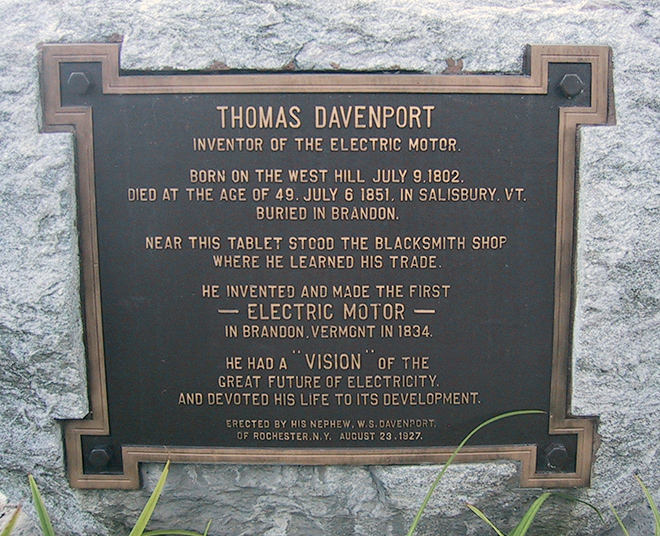
1837: The U.S. Patent Office approves Thomas Davenport’s application for a patent on an “Improvement in Propelling Machinery by Magnetism and Electro-Magnetism.” We’d call it an electric motor.
Davenport was a Vermont blacksmith and an amateur tinkerer, not a trained scientist or engineer. When he heard about a machine that used an electromagnet to separate high-quality iron ore from the lower-grade stuff, he became intrigued. Unable to meet with the inventor, he sold his brother’s horse and a number of other possessions to buy an electromagnet of his own.
Like many Wired readers, Davenport then proceeded to take apart the nifty gadget he’d just bought in order to find out how it was made. Soon he was making his own batteries and electromagnets, and in half a year had come up with a motor powered by direct current from a galvanic wet cell.
Davenport’s wife, Emily, maintained notes for him and even suggested modifications and materials to be used in his experiments. She also contributed strips of silk from her wedding dress to use as insulation for the wires.
The brush-and-commutator scheme Davenport invented is still used in electric motors today. Current flows through electromagnets mounted on a wheel, causing them to move towards fixed permanent magnets, rotating the wheel through a half turn. As the wheel turns, its motion breaks the circuit powering the magnets and connects a new circuit with opposite polarity. That in turn reverses the polarity of the electromagnets, pushing each one away from the magnet it’s just passed while pulling it towards the next magnet in the circle, thus pushing the wheel through another half turn. The process repeats, and the wheel on the motor goes round and round.
Reading the patent application, you can almost see the patent examiners’ brains quietly exploding. Electricity was still a rather novel concept, despite the fact that people had been experimenting with it for nearly a century, and nobody had tried to patent an electrical device before. The three-page application is elegant, concise and to the point, but the description is a bit hard to follow at some places — and that’s with the benefit of 170 extra years of electrical knowledge behind us.
Davenport’s first patent application was rejected. After winning the endorsement of a number of distinguished men of science, building a working model, rebuilding the model after it was destroyed in a fire, and resubmitting his application, Davenport finally won the patent he’d been seeking.
It was issued U.S. Patent No. 132, because the 9,957 patents issued between July 31, 1790, and July 13, 1836, weren’t numbered.
Davenport had high hopes for his invention: He foresaw using it to power shop machinery and even locomotives. He set up a workshop near Wall Street in New York and published his own promotional newspaper, The Electro-Magnet and Mechanics Intelligencer, which he printed on an electric-motor–powered printing press.
But as a business, the electric motor was a flop. The batteries of the day were too weak, too bulky and too unpredictable to provide reliable power. That didn’t keep the intrepid Vermonter from inventing an electric locomotive and even an electric piano.
It took nearly 50 years before inventors like Thomas Edison started using Davenport’s motor in reverse to generate power, something Davenport had never foreseen (but which Faraday demonstrated in 1831). Once it was possible to use water or steam to generate electricity in large quantities using these generators, electric motors became more practical and were soon employed in trains and trolleys, just as Davenport had envisioned.
Davenport reportedly died bankrupt, a few days short of his 49th birthday in 1851. His patent model for the electric motor now sits in the Smithsonian Institution in Washington.
Source: Various
Photo: jessamyn/Flickr
Prita Ganapati also contributed to this article.
Feb. 25, 1837: Davenport Electric Motor Gets Plugged In | This Day In Tech | Wired.com.